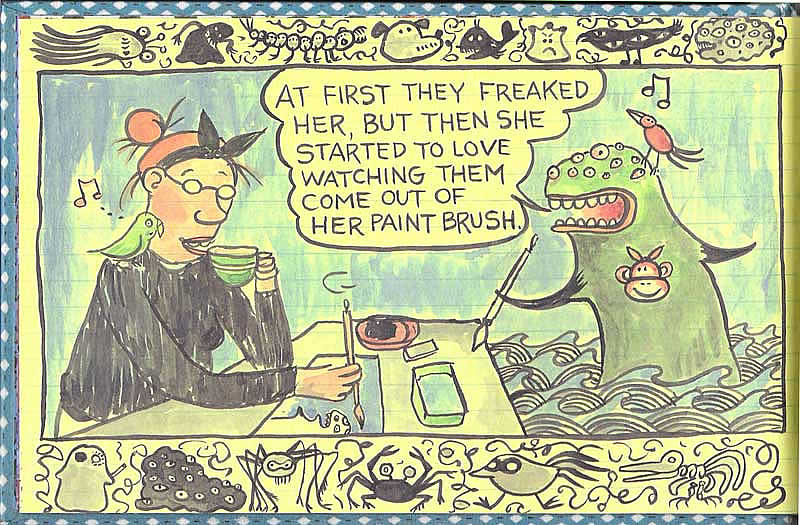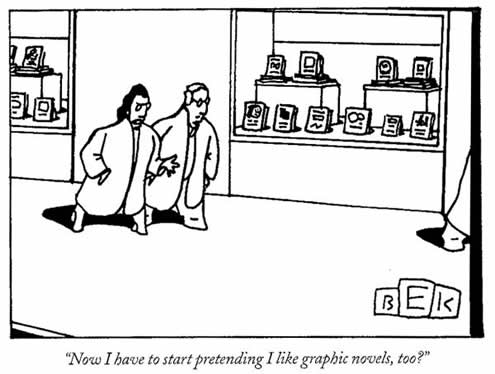
- Eric Rabkin - course instructor
- TTh 1:10-2:30 2455 Mason Hall
- Consultation
- 3243 Angell Hall TWTh 3:10-4:00 & by appt
esrabkin@umich.edu & 734-764-2553
- Senior seminar writing instructors
- Fritz Swanson 3145 Angell Hall
T 9-11, 12-2, 4-5, Th 9-11, 12-2, 4-5
fgs@umich.edu & 734-647-3086
Also available:
Peggy Adler 3138 Angell Hall
M 10-1, T 1-5, W 10-1
adlerp@umich.edu & 936-1558
Anne Berggren 1126 Angell Hall
M 12-2, Th 1-5, F 1-5
agbergrn@umich.edu & 936-3141
| Course Overview | Course Calendar | graphic.narrative.w05@umich.edu |
| Written Work & Course Grades | Online Resources | Disability Accommodations |
| A Note on Obtaining Books | Supplementary Materials | Plagiarism |
COURSE OVERVIEW
Graphic Narrative is a general term for Comic Books, Graphic Novels, Manga, Bandes Dessinées, Novelas Em Quadrinhos, Sequential Art, and even the Bayeux Tapestry. This seminar enrolls both advanced undergraduates (in English 417 Senior Seminar, 4 credits) and graduate students (in English 549 Contemporary Literature, 3 credits). We will use both primary (P) and secondary (S) readings to explore the modern history and theory of the field, the sociology of the field, and a rich assortment of excellent examples of many literary types within the field.
(return to top)
WRITTEN WORK & COURSE GRADES
The written work consists of a daily reading journal, a 5-8 page paper on a graphic (not chapter) children's
book, and a 10-15 page paper either on some general aspect of graphic narrative (e.g., the use of framing, the use of thought bubbles, the use of color, the techniques of visual allusion, palimpsest, collage, the varieties of irony, the relations between drawing style and meaning, the handling of a specific theme, the uses of a specific image, cultural constraints on meaning, etc.) or on some aspect of the work of a single important graphic narrative artist, series, or genre. In all three assignments, students are expected to consider both the form and the content of the materials read and to argue for insights that go substantially beyond the discussion in class. In the reading journal, students are expected to record (a) any extrinsic details potentially relevant to a critical discussion of the work (including at least type of work, name and nationality of writer and/or illustrator, date and place of publication, publisher, format), (b) observations as one reads, including page references and quotes (which may need to include photocopies), and (c) conclusions and/or hypotheses and/or questions that seem noteworthy after reviewing (a) and (b) and perhaps the work as well. The journals should be hand-written (printed if necessary for clarity) with two-inch margins all around because these journals will be exchanged at the beginning of each class meeting, read by a fellow student, and the contents commented on in the margins. The journal should be kept in a spiral-bound notebook into which can be glued copies of graphics if needed. When the journals are submitted at the end of the semester, they should be accompanied by a printed, double-spaced, two-page self-analysis of the worth (both educational and in terms of grade) of the journal to the student. The two "papers" should be submitted as Word files sent as e-mail attachments to the instructor. The topics for the two papers must be approved by the instructor in advance. In the two papers, the page lengths refer to the student's written text, which should be produced as standard text (double-spaced Arial 12, one-inch margins all around) but these papers are also expected to include appropriate graphics at the end and textual hyperlinks to those graphics. Students registered under 417 will be expected to submit a draft of each paper in advance of its due date to the writing instructor participating in the course. These students will be allowed, at the writing instructor's discretion, to revise the first paper for grade. Students registered under 549 will not be allowed to revise for grade but are encouraged to consult with the course instructor and with the writing instructor in advance of submitting each paper. The course grades will be based on participation (25%), journal + journal evaluation essay (25%), children's book paper (20%), general paper (30%).
(return to top)
A NOTE ON OBTAINING BOOKS
Because they are illustrated, printed in unusual formats, and often use special papers, the books studied in this course are necessarily more expensive on a per page basis than books studied in a course focused on traditional textual narrative. Since many of the books studied in this course are quite short, we need to read more books than we would in a course on traditional textual narrative. Thus, unfortunately, the book costs in this course are unusually high. As a way of easing this burden, some students may want to share books. Also, a small number of most of the books will be available on reserve. (In order to use the Library Reserve Service as efficiently as possible, Reserve Loan Periods have been set at differing lengths as shown in the course calendar below. Please check the Library Course Reserves Service to see if the book you want is available.) Finally, Shaman Drum has generously agreed to sell these course books to students in our course at a 15% discount.
(return to top)
Date |
Reading Week |
Text Type |
Title, Author |
Reserve Period |
Th 6 Jan |
Introduction of subject, class, and class members |
|||
T 11 Jan |
1 |
S |
Comics, Comix & Graphic Novels, Roger Sabin |
3 days |
T 18 Jan |
2 |
S |
Picture This: How Pictures Work, Molly Bang |
2 hours |
| S |
Understanding Comics, Scott McCloud |
3 d |
||
T 25 Jan |
3 |
P |
Dreams of the Rarebit Fiend, Winsor McCay |
4 h |
| P |
Krazy & Ignatz 1929-1930, George Herriman |
4 h |
||
T 1 Feb |
4 |
P |
If I Ran the Zoo, Dr. Seuss |
2 h |
| P |
Amphigorey, Edward Gorey |
1 d |
||
| P |
The Stinky Cheese Man, Jon Scieszka and Lane Smith |
2 h |
||
Th 3 Feb |
Finalize proposals for shorter paper |
|||
T 8 Feb |
5 |
S & P |
The Great Comic Book Heroes, Jules Feiffer |
3 d |
T 15 Feb |
6 |
S & P |
Black Images in the Comics: A Visual History, Frederik Strömberg |
1 d |
| P | Birth of a Nation, Aaron McGruder |
2 h | ||
T 22 Feb |
7 |
P |
Asterix the Gaul, René de Goscinny |
2 h |
| S |
Manga! Manga!: The World of Japanese Comics, Frederik L. Schodt |
3 d |
||
T 8 Mar |
8 |
P |
Watchmen, Alan Moore |
3 d |
T 15 Mar |
9 |
P |
Maus (vols 1 & 2), Art Spiegelman |
3 d |
Th 17 Mar |
Finalize proposals for longer paper |
|||
T 22 Mar |
10 |
P |
The Dark Knight Returns, Frank Miller |
3 d |
T 29 Mar |
11 |
P |
Jimmy Corrigan: The Smartest Kid on Earth, Chris Ware |
3 d |
T 5 Apr |
12 |
P |
Blood Song, Eric Drooker |
2 h |
| P |
Blankets, Craig Thompson |
3 d |
||
T 12 Apr |
13 |
P |
One Hundred Demons, Lynda Barry |
1 d |
T 19 Apr |
Summation. Journals w/ self-analyses due in class; longer papers due by midnight |
ONLINE RESOURCES:
U-M Department of English Resources for Readers and Writers
U-M Fantasy and Science Fiction Web Site
U-M Fantasy and Science Fiction Web Site Dictionary of Symbolism
U-M Library Networked Electronic Resources (may require login):
GaleNet (authors & literary criticism)
Humanities Text Initiative (searchable texts and text collections)
Oxford English Dictionary (meanings, etymologies, and quotations)
Encyclopedia Britannica
Modern Language Association Bibliography (literary criticism)
(return to top)

The Anime Project
Bayeux Tapestry
Citation Style for Graphic Narrative Criticism
Coconino World
Comic Art & Graffix Gallery (history of comics, biographies of artists and writers, etc.)
Five Ways of Looking At a Thesis
Lambiek.net (comics encyclopedia, etc.)
Logic and Literary Argument
Lowering Image File Size
MLA Citation Style (Format) with Examples
Phoebe Gloeckner's Comics Course
Rocco Versaci's Spotlight on Comics
Secure Materials (restricted to U-M community for instructional and scholarly purposes)
Some Questions for Active Reading of Fiction
U-M Library Course Reserves Service
includes required books and the following recommended book:
Trina Robbins, A Century of Women Cartoonists (3 day reserve)
Wikipedia (see under "comic book," "graphic novel," etc.)
Writing Samples for Use of Evidence
(return to top)